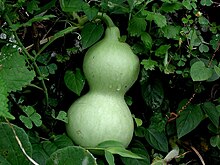
Back ቅል Amharic Lagenaria siceraria AN دباء Arabic كالاباش خيارى ARZ জাতি লাউ Assamese Lagenaria siceraria AST लौकी AWA Adi su qabağı Azerbaijani عادی سۇ قاباغی AZB Upo BCL
| Calabash | |
|---|---|

| |
| Green calabash growing on its vine | |
| Scientific classification | |
| Kingdom: | Plantae |
| Clade: | Tracheophytes |
| Clade: | Angiosperms |
| Clade: | Eudicots |
| Clade: | Rosids |
| Order: | Cucurbitales |
| Family: | Cucurbitaceae |
| Genus: | Lagenaria |
| Species: | L. siceraria
|
| Binomial name | |
| Lagenaria siceraria | |
| Synonyms[1] | |
|
List
| |
Calabash (/ˈkæləbæʃ/;[2] Lagenaria siceraria), also known as bottle gourd,[3] white-flowered gourd,[4] long melon, birdhouse gourd,[5] New Guinea bean, New Guinea butter bean, Tasmania bean,[6] and opo squash, is a vine grown for its fruit. It can be either harvested young to be consumed as a vegetable, or harvested mature to be dried and used as a utensil, container, or a musical instrument. When it is fresh, the fruit has a light green smooth skin and white flesh.
Calabash fruits have a variety of shapes: they can be huge and rounded, small and bottle-shaped, or slim and serpentine, and they can grow to be over a metre long. Rounder varieties are typically called calabash gourds. The gourd was one of the world's first cultivated plants grown not primarily for food, but for use as containers. The bottle gourd may have been carried from Asia to Africa, Europe, and the Americas in the course of human migration,[7] or by seeds floating across the oceans inside the gourd. It has been proven to have been globally domesticated (and existed in the New World) during the Pre-Columbian era.
There is sometimes confusion when discussing "calabash" because the name is shared with the unrelated calabash tree (Crescentia cujete), whose hard, hollow fruits are also used to make utensils, containers, and musical instruments.[8]
- ^ "Lagenaria siceraria (Molina) Standl". Plants of the World Online. Board of Trustees of the Royal Botanic Gardens, Kew. 2017. Retrieved 2 December 2020.
- ^ "calabash noun - Definition, pictures, pronunciation and usage notes | Oxford Advanced Learner's Dictionary at". Oxfordlearnersdictionaries.com. Retrieved 6 May 2022.
- ^ USDA, NRCS (n.d.). "Lagenaria siceraria". The PLANTS Database (plants.usda.gov). Greensboro, North Carolina: National Plant Data Team. Retrieved 22 January 2016.
- ^ BSBI List 2007 (xls). Botanical Society of Britain and Ireland. Archived from the original (xls) on 26 June 2015. Retrieved 17 October 2014.
- ^ "Grow Birdhouse Gourds". FineGardening. 25 April 2009. Retrieved 25 July 2021.
- ^ Hill, Kathryn (1 September 2009). "Ingredient Spotlight: Cucuzza ("Googootz")". The Kitchn.
- ^ Cite error: The named reference
pmid16352716was invoked but never defined (see the help page). - ^ Price, Sally (1982). "When is a calabash not a calabash". New West Indian Guide: 56:69–82.
© MMXXIII Rich X Search. We shall prevail. All rights reserved. Rich X Search